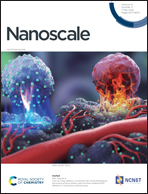Stretchable, breathable, and highly sensitive capacitive and self-powered electronic skin based on core–shell nanofibers†
Abstract
Fiber-based nanostructures are greatly desired for the improvement of wearable/flexible electronics, which are expected to be stretchable, conformable, flexible, and long-term. Herein, an ultra-stretchable, breathable, and highly sensitive flexible capacitive tactile sensor and triboelectric effect core–shell nanofibers are proposed. In particular, core–shell ionic TPU/PVDF-HFP nanofibers are effectively prepared by an electrospinning approach. The core–shell ionic TPU/PVDF-HFP nanofibers exhibit high performance as a capacitive flexible sensor with high sensitivity (0.718 kPa−1) in a low linear pressure range (0–1.2 kPa), an ultralow detection limit (7 Pa), a rapid response and recovery time, and excellent stability. Moreover, we assembled a self-powered pressure sensor, which has a sensitivity of 0.071 V kPa−1 in the high linear pressure range of 90 kPa to 400 kPa. The increase in the inductive charges of the nanofiber layer allows it to work as an energy harvester with a high power density (1.6 W m−2) that can light up 100 LEDs instantly. These remarkable results allow the capacitive flexible devices to be applied in various applications, such as spatial pressure mapping, bending angle detection, soft grabbing, and physiological signal monitoring.



 Please wait while we load your content...
Please wait while we load your content...